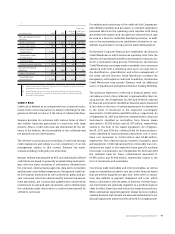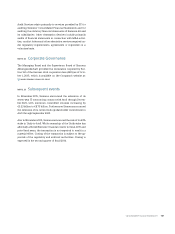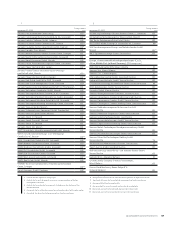Siemens 2015 Annual Report Download - page 104
Download and view the complete annual report
Please find page 104 of the 2015 Siemens annual report below. You can navigate through the pages in the report by either clicking on the pages listed below, or by using the keyword search tool below to find specific information within the annual report.Consolidated Financial Statements
RECONCILIATION TO
CONSOLIDATED FINANCIAL STATEMENTS
Centrally managed portfolio activities (CMPA) – in gen-
eral, comprises equity stakes held by Siemens that are ac-
counted for by the equity method or as available-for-sale finan-
cial assets and that for strategic reasons are not allocated to a
segment, Siemens Real Estate (SRE), Corporate items or Corpo-
rate Treasury. CMPA also includes activities generally intended
for divestment or closure as well as activities remaining from
divestments and discontinued operations.
Siemens Real Estate (SRE) – manages the Group’s entire real
estate business portfolio, operates the properties, and is re-
sponsible for building projects and the purchase and sale of
real estate.
Corporate items
– includes corporate charges such as person-
nel costs for corporate headquarters, corporate projects and
non-operating investments or results of corporate-related de-
rivative activities.
Pensions – includes the Company’s pension related income
(expense) not allocated to the segments, SRE or Centrally man-
aged portfolio activities.
Eliminations, Corporate Treasury and other reconciling
items
– comprise consolidation of transactions within the seg-
ments, certain reconciliation and reclassification items and the
activities of the Company’s Corporate Treasury. It also includes
interest income and expense, such as, for example, interest not
allocated to segments or Centrally managed portfolio activities
(referred to as financing interest), interest related to Corporate
Treasury activities or resulting consolidation and reconciliation
effects on interest.
MEASUREMENT – SEGMENTS
Accounting policies for Segment information are generally the
same as those used for Siemens. Lease transactions, however,
are classified as operating leases for internal and segment re-
porting purposes. Intersegment transactions are based on mar-
ket prices.
Profit
Siemens’ Managing Board is responsible for assessing the per-
formance of the segments (chief operating decision maker).
The Company’s profitability measure of the segments except
for SFS is earnings before financing interest, certain pension
costs, income taxes and amortization expenses of intangible
assets acquired in business combinations as determined by the
chief operating decision maker (Profit). The major categories of
items excluded from Profit are presented below.
Financing interest, excluded from Profit, is any interest income
or expense other than interest income related to receivables
from customers, from cash allocated to the segments and inter-
est expenses on payables to suppliers. Financing interest is ex-
cluded from Profit because decision-making regarding financ-
ing is typically made at the corporate level.
Decisions on essential pension items are made centrally.
Accordingly, Profit primarily includes amounts related to ser-
vice cost of pension plans only, while all other regularly recur-
ring pension related costs are included in reconciliations in line
item Centrally carried pension expense.
Amortization expenses of intangible assets acquired in busi-
ness combinations are not part of Profit. Furthermore, income
taxes are excluded from Profit since income tax is subject to
legal structures, which typically do not correspond to the struc-
ture of the segments.
The effect of certain litigation and compliance issues is ex-
cluded from Profit, if such items are not indicative of perfor-
mance. This may also be the case for items that refer to more
than one reportable segment, SRE and (or) Centrally managed
portfolio activities or have a corporate or central character. Costs
for support functions are primarily allocated to the segments.
Profit of the segment SFS:
Profit of the segment SFS differs from the other segments since
SFS uses Income before income taxes as a measure of profit.
In contrast to performance measurement principles applied to
other segments interest income and expenses is an important
source of revenue and expense of SFS.
























